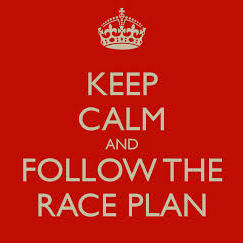Half/Full Marathon Game Plan
"Wow, it's awfully early in the race for some of these runners to have the thousand-yard stare," proclaimed one of my coaches as we cheered on the throng that ran before us.
 Wikipedia describes the “thousand-yard stare” as "the limp, blank, unfocused gaze of a battle-weary soldier." To be certain, there were several battle-weary runners way too early in the race. Marathoners spend so much time developing an excellent training plan, but all too often they neglect an actual race plan. And in that case, ignorance is not always bliss. If they plan to run 13.1 or 26.2 miles without a game plan, they're setting themselves up for failure.
Wikipedia describes the “thousand-yard stare” as "the limp, blank, unfocused gaze of a battle-weary soldier." To be certain, there were several battle-weary runners way too early in the race. Marathoners spend so much time developing an excellent training plan, but all too often they neglect an actual race plan. And in that case, ignorance is not always bliss. If they plan to run 13.1 or 26.2 miles without a game plan, they're setting themselves up for failure.
The primary focus of a race plan for a half or full marathon should be pacing. There are three basic styles of pacing we can utilize: positive split, negative split, and even pacing.
A positive split race is going out fast and trying to hang on. The idea behind this is "banking" time. The problem with this pacing strategy, however, is that you'll blow through your glycogen stores at an alarming rate and produce lactic acid faster than you can clear it. That means you will inevitably slow down and hurt much more than is necessary.
A negative split race is starting slowly (often slower than your goal pace) and speeding up as the race goes on.
Even split pacing is running at an even, steady pace throughout the entire race. Even and negative split pacing allow your body to ration glycogen stores and still have some gas in the tank as you get to the later stages of the race.
Every world record from the mile to the marathon has been set at an even-to-slightly-negative split race. That means you don't want to run the first mile or two too fast, which is a very common mistake. Every single second faster per mile that you are ahead of optimal pace early on will require payment—with interest—later. But staying in control early in the race—when your adrenaline is flowing and other runners are tearing out of the gates at suicide pace—can be difficult. It requires a lot of focus. Your normal half or full marathon pace may feel incredibly slow, so be prepared. Pay attention to your pace and don’t go out too fast.
Here are a few ways to keep your pace in place.
Athletes who are new to the half or full marathon or who just want to enjoy the race should follow the KISS method: Keep It Simple, Stupid. Your first race shouldn’t have a goal time. Your main goal is to cross the finish line happy and healthy. The best way to achieve this is to think of the race as a 10-mile warm up for a 5K race (half marathon) or a 20-mile warm up for a 10K race (full marathon). You want to get to the toughest part of the race feeling good and ready to race. Pushing your body too soon can ruin an experience that should be memorable (in a good way). Take it easy, enjoy the view, be inspired by the other runners, soak in the experience, and finish with a smile on your face (there are cameras at the finish line).
Athletes who are experienced and looking to perform at their highest level on race day should follow a more detailed game plan. The best way to wrap your head around a race is to break up the race into practical chunks. For the full marathon, you should divide your race into four 10Ks; for the half marathon, you should divide your race into four 5Ks. The first chunk should be your slowest. Let your body warm up into the race. There should be little to no effort during this part—like you’re just flitting down the road. The next chunk should be right around race pace. This is when your legs start to go through a more normal range of motion, a more natural run. But don't hit the gas pedal too soon. You should still feel awesome at this point in the race. The third 10K/5K will require work. This chunk might be just a few seconds-per-mile faster than race pace. The goal is get to the start of your final 10K/5K at goal race pace and have as much energy left over as possible. If you've run intelligently and held yourself back (assuming Mother Nature and the GI gods are cooperating), your last 10K/5K has the potential to be your fastest. The key is that you don’t push the pace too early. Throw pride and worry out the window. Your shot at a PR doesn’t even start until miles 18-20. Use self-discipline and willpower to hold yourself back early in the race. You’ll reap the rewards later. This doesn't mean the last portion will be easy, it simply means it will be manageable.
Here are a few other things to remember when you’re making your race plan:
One Move | You have one opportunity to make a big move in a race. Unfortunately, most people use it in the first mile or so. But making the mistake of being too quick early on hurts you more than it helps you. If you use that one move over the last half-mile, you won’t have to worry about the negative post move consequences—because the race will be over.
Even Pace is NOT Even Effort | Another common mistake most folks make when they try to run an even-to-negative split pace is that they run even effort. Over the course of a race, you will fatigue, and you will have to work harder to stay on pace. Early on it'll feel like you're walking. Make sure to keep your pace in check without working hard to run slow. Simply turn off the muscles you don't need to run that speed (i.e., keep your arms relaxed and your stride short.)
Know the Course | Know which points on the course are good for making time and which points on the course might cause you to lose time. Running uphill is tougher than running flat terrain. Long stretches into the wind, gravel (about 20 seconds per mile harder than roads), and congested areas (turns and bottlenecks) are all factors that can negatively affect your time. Downhills, nice wide straightaways, and tail winds can help you gain time. By preparing for these spots, you can stockpile extra energy in the easy sections and use it in the tough sections.
The Moment of Doubt | Finally, be prepared for the moment of doubt. Every person who truly digs deep and pushes himself in a race goes through that rough patch. It's that moment when you’re not sure if you can keep going at a particular effort level. All athletes—even Olympians—go through this. And since you know it’s coming, you need to prepare. When the pain and bad patches come, accept them as a good and necessary step to unveiling another level of success. Do NOT think, “Oh, man. Here I go again…” Instead, redirect your focus to something else. Focus on technique: quicken your turnover for the next thirty seconds, drive your arms back, go through a mental checklist to relax tight hands, arms, and shoulders. By focusing on using your muscles differently, you’ll distract yourself from your doubt, and the moment will pass. By being prepared mentally, you can keep your pace from dragging.
These strategies are a framework to help you see the forest thru the trees, so to speak. Make them your own, taking into account your strengths. By planning and preparing for the effort ahead, you can hit the start ready to roll. Remember: you have a choice on how to run your race. Choose wisely, grasshopper.
 Tim Cary is Head Track & Field and Cross Country for Lindenwood University at Belleville and the former Fleet Feet Assistant Training Manager. Over his more than two decades of coaching, Tim has coached athletes to three national team championships, five national individual championships, two national records, and numerous All-American and All-State honors. Click here to subscribe to our blog.
Tim Cary is Head Track & Field and Cross Country for Lindenwood University at Belleville and the former Fleet Feet Assistant Training Manager. Over his more than two decades of coaching, Tim has coached athletes to three national team championships, five national individual championships, two national records, and numerous All-American and All-State honors. Click here to subscribe to our blog.
Connect With Us
see the latest from Fleet Feet St. Louis